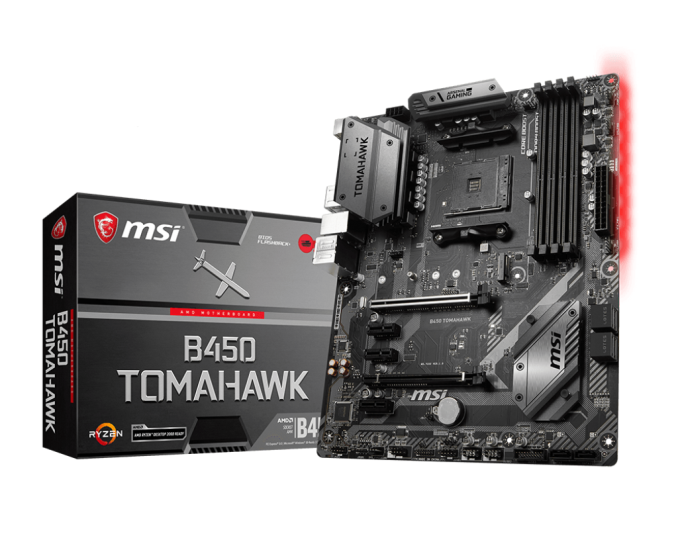The MSI B450 Tomahawk Motherboard Review: More Missile Than Axe
by Gavin Bonshor on December 11, 2018 8:00 AM EST- Posted in
- Motherboards
- AMD
- MSI
- Zen
- AM4
- Ryzen
- Tomahawk
- Ryzen 2
- B450
- Entry Level
- MSI B450 Tomahawk
MSI B450 Tomahawk Conclusion
The MSI B450 Tomahawk had a launch pricing of $120 but can be more commonly found for $100 which not only increases the ever important value factor but means the extra money saved can be allocated to other areas of system improvement such as storage. The B450 Tomahawk is an ATX sized entry-level offering, but when compared to other B450 options it's actually more mid-range and offers a host of price conscientious controllers as a result.
Performance on the whole for the B450 Tomahawk is modestly average in most of the areas. Where it shines is in the power consumption, where it is essentially the best AM4 board we've tested. By comparison, the audio performance wasn't so good, with it coming last out of all the ALC892 boards we've tested.
The MSI Arsenal range of motherboard are primarily targeted at budget gamers and the Tomahawk is positioned as the best from MSI of this particular range. While it's been mentioned throughout much of the review that this board is the successor to the B350 Tomahawk, it's important to highlight the improvements MSI has done to keep their product range as progressive as possible for the consumer. The biggest win in this regard is the power delivery, but not just the componentry (which includes the replacement of NIKOS MOSFETs with those from ON Semiconductor), but MSI has implemented a much cleaner and seemingly more effective 4+2 power delivery with two high side and two low side MOSFETs per phase. The power delivery heatsink also gets a noticeable upgrade in terms of surface area on the top due to a newer extended design, as well as making the heatsinks themselves larger in size, heavier in mass and the B450 Tomahawk heatsinks now actually have fins instead of looking like lazy lumps of metal.
Another plus is the inclusion of two USB 3.1 Gen2 ports on the rear panel which MSI did omit from the last AM4 Tomahawk branded board. The superfast 10 Gbps capabilities come through a Type-A and Type-C port while the rear panel also features a further two USB 3.1 Gen1 Type-A ports and two USB 2.0 ports.
With a current retail pricing of $100, it's hard to ignore the B450 Tomahawk and offers users looking to build a good value gaming themed system with a solid foundation to build upon. The gap between the more budget B450 chipset and higher end X470 chipset boards is bridging ever closer, and this board is a good example of that.












36 Comments
View All Comments
FoRealz - Tuesday, December 11, 2018 - link
I have two questions:1. Why are b/x/h 400 boards performing worse than their predecessors?
2. Why are ps/2 ports making a comeback?
I'm currently on an Asus z270 tuf mark 1 and my board has so much more than the newer tuf boards. (2 lans, etc) I'm really confused as to why boards have been going downhill nomatter Intel or AMD.
PeachNCream - Tuesday, December 11, 2018 - link
I don't understand PS/2 ports on new motherboards at this point. There aren't a lot of interface devices out there that have survived and I don't see indications that production of PS/2 keyboards and mice are still going. Legacy-free and/or using that IO cluster space for something else might be useful.The_Assimilator - Wednesday, December 12, 2018 - link
It's because of the eSports idiots who still believe that USB is inferior because it polls.gavbon - Wednesday, December 12, 2018 - link
That makes more sense - eSports, euuurgh!bananaforscale - Wednesday, December 12, 2018 - link
Well, it *is*, but you're not going to notice the difference. :P And if there's something at a higher priority than the USB driver, well...kn00tcn - Sunday, December 16, 2018 - link
that's just false, you just want an excuse to to act elitistthere is another anand article that explains why, figure it out if you're not an idiot
plonk420 - Friday, December 14, 2018 - link
it's OCing and gaming... USB sometimes has fits with certain types of OCing (BCLK, i think? i don't OC almost ever). also IIRC from a recent Carmack talk, PS/2 interrupts the OS to give its input, whereas USB input enters queues and buffers before being processedgavbon - Wednesday, December 12, 2018 - link
1. It could be driver/chipset driver related; we have also just had a change in our test suite/driver going forward for 2019.2. That's a hard one to answer. Budget boards tend to have them as well as overclocking focused motherboards more than premium models. It could be that they don't expect all budget users to have adopted USB yet? It's an interesting question though...
kn00tcn - Sunday, December 16, 2018 - link
if you're gavin, how did you forget ian's article for win7? https://www.anandtech.com/show/11182/how-to-get-ry...ps/2 is for win7, not budget
kn00tcn - Sunday, December 16, 2018 - link
'every' [citation needed] am4 mobo has ps/2, did you forget it supports win7? you cant even run the installation without usb drivers or ps/2 inputintel doesnt even provide win7 drivers, so nobody needs ps/2